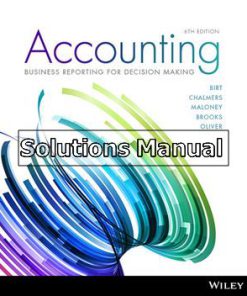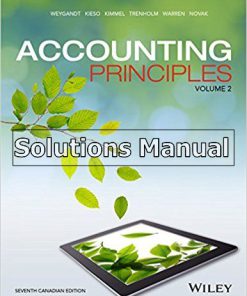Advanced Accounting 7th Edition Jeter Solutions Manual
You may also like
-
$26.50
$50.00
Advanced Accounting 7th Edition Jeter Solutions Manual

Product details:
- ISBN-10 : 1119373204
- ISBN-13 : 978-1119373209
- Author: Debra C. Jeter, Paul K. Chaney
Advanced Accounting delivers an in-depth, comprehensive introduction to advanced accounting theory and application, using actual business examples and relevant news stories to demonstrate how core principles translate into real-world business scenarios. Clearly defined and logically organized Learning Objectives aid in student comprehension, while highlighted Related Concepts illustrate how individual concepts fit into the larger picture. Short answer questions throughout the chapter allow students to test their knowledge before reaching the more in-depth end-of-chapter questions, promoting a deeper understanding of both technical and conceptual aspects of the field.
Written by active accounting researchers, this text brings clarity and flexibility to the central ideas underlying business combinations, consolidated financial statements, foreign currency transactions, partnerships, non-profit accounting and more. This new Seventh Edition has been updated to reflect the latest changes to FASB and GASB standards, allowing students to build a skill set based on up-to-date practices. With a student-oriented pedagogy designed to enhance comprehension, promote engagement, and build real-world understanding, this user-friendly book provides an essential foundation in current advanced accounting methods and standards.
Table contents:
Chapter 1: Introduction to Business Combinations and the Conceptual Framework
Learning Objectives
1.1 Growth Through Mergers
1.2 Nature of the Combination
1.3 Business Combinations: Why? Why not?
1.4 Business Combinations: Historical Perspective
1.5 Terminology and Types of Combinations
1.6 Takeover Premiums
1.7 Avoiding the Pitfalls before the Deal
1.8 Determining Price and Method of Payment in Business Combinations
1.9 Alternative Concepts of Consolidated Financial Statements
1.10 FASB’s Conceptual Framework
1.11 FASB Codification (Source of GAAP)
Summary
Question
Analyzing Financial Statements
Exercises
ASC Exercises
Chapter 2: Accounting for Business Combinations
Learning Objectives
2.1 Accounting Standards on Business Combinations: Background
2.2 Illustration of Acquisition Accounting
2.3 Bargain Purchase Accounting
2.4 Measurement Period and Measurement Period Adjustments
2.5 Goodwill Impairment Test
2.6 Contingent Consideration (Earnouts)
2.7 Proforma Statements and Disclousre Requirements
2.8 Leveraged Buyouts
2.9 IFRS versus U.S. GAAP
Summary
Question
Analyzing Financial Statements
Exercises
ASC Exercises
Chapter 3: Consolidated Financial Statements-Date of Acquisition
Learning Objectives
3.1 Definitions of Subsidiary and Control
3.2 Requirements for the Inclusion of Subsidiaries in the Consolidated Financial Statements
3.3 Reasons for Subsidiary Companies
3.4 Consolidated Financial Statements
3.5 Investments at the Date of Acquisition
3.6 Consolidated Balance Sheets: The Use of Workpapers
3.7 A Comprehensive Illustration-More than One Subsidiary Company
3.8 Limitations of Consolidated Statements
Summary
Question
Analyzing Financial Statements
Exercises
ASC Exercises
Chapter 4: Consolidated Financial Statements After Acquisition
Learning Objectives
4.1 Accounting for Investments By the Cost, Partial Equity, and Complete Equity Methods
4.2 Consolidated Statements After Acquisition—Cost Method
4.3 Recording Investments in Subsidiaries—Equity Method (Partial Or Complete)
4.4 Elimination of Intercompany Revenue and Expense Items
4.5 Interim Acquisitions of Subsidiary Stock
4.6 Consolidated Statement of Cash Flows
4.7 Illustration of Preparation of a Consolidated Statement of Cash Flows—Year of Acquisition
4.8 Compare U.S. GAAP and IFRS Regarding Equity Method
Summary
Question
Analyzing Financial Statements
Exercises
ASC Exercises
Chapter 5: Allocation and Depreciation of Differences Between Implied and Book Values
Learning Objectives
5.1 Computation and Allocation of the Difference Between Implied and Book Values to Assets and Liabilities of Subsidiary–Acquisition Date
5.2 Effect of Differences Between Implied and Book Values on Consolidated Net Income—Year Subsequent to Acquisition
5.3 Consolidated Statements Workpaper—Using the Cost Method
5.4 Controlling and Noncontrolling Interests in Consolidated Net Income and Retained Earnings—Using the Cost Method
5.5 Consolidated Statements Workpaper—Using Partial Equity Method
5.6 Controlling and Noncontrolling Interests in Consolidated Net Income and Retained Earnings—Using Partial Equity Method
5.7 Consolidated Statements Workpaper—Using Complete Equity Method
5.8 Controlling Interest in Consolidated Net Income and Retained Earnings—Using Complete Equity Method
5.9 Additional Considerations Relating to Treatment of Difference Between Implied and Book Values
5.10 Push Down Accounting
5.11 IFRS Vs U.S. GAAP on Research & Development Costs
Summary
Question
Analyzing Financial Statements
Exercises
ASC Exercises
Chapter 6: Elimination of Unrealized Profit on Intercompany Sales of Inventory
Learning Objectives
6.1 Effects of Intercompany Sales of Merchandise on the Determination of Consolidated Balances
6.2 Cost Method: Consolidated Statements Workpaper—Upstream Sales
6.3 Cost Method—Analysis of Consolidated Net Income and Consolidated Retained Earnings
6.4 Consolidated Statements Workpaper—Partial Equity Method
6.5 Partial Equity Method—Analysis of Consolidated Net Income and Consolidated Retained Earnings
6.6 Consolidated Statements Workpaper—Complete Equity Method
6.7 Complete Equity Method—Analysis of Consolidated Net Income and Consolidated Retained Earnings
6.8 Summary of Workpaper Entries Relating to Intercompany Sales of Inventory
6.9 Intercompany Profit Prior to Parent-Subsidiary Affiliation
Summary
Question
Analyzing Financial Statements
Exercises
ASC Exercises
Chapter 7: Elimination of Unrealized Gains Or Losses on Intercompany Sales of Property and Equipment
Learning Objectives
7.1 Intercompany Sales of Land (Nondepreciable Property)
7.2 Intercompany Sales of Depreciable Property (Machinery, Equipment, and Buildings)
7.3 Consolidated Statements Workpaper—Cost and Partial Equity Methods
7.4 Calculation of Consolidated Net Income and Consolidated Retained Earnings
7.5 Consolidated Statements Workpaper—Complete Equity Method
7.6 Calculation and Allocation of Consolidated Net Income; Consolidated Retained Earnings: Complete Equity Method
7.7 Summary of Workpaper Entries Relating to Intercompany Sales of Equipment
7.8 Intercompany Interest, Rents, and Service Fees
Summary
Question
Analyzing Financial Statements
Exercises
ASC Exercises
Chapter 8: Changes in Ownership Interest
Learning Objectives
8.1 Changes in Ownership
8.2 Parent Acquires Subsidiary Stock Through Several Open-Market Purchases—Cost Method
8.3 Parent Sells Subsidiary Stock Investment on the Open Market—Cost Method
8.4 Equity Method—Purchases and Sales of Subsidiary Stock By the Parent
8.5 Parent Sells Subsidiary Stock Investment on the Open Market—Cost Method
8.6 Subsidiary Issues Stock
Summary
Question
Analyzing Financial Statements
Exercises
ASC Exercises
Chapter 9: Intercompany Bond Holdings and Miscellaneous Topics—Consolidated Financial Statements
Learning Objectives
9.1 Intercompany Bond Holdings
9.2 Accounting for Bonds—A Review
9.3 Constructive Gain Or Loss on Intercompany Bond Holdings
9.4 Accounting for Intercompany Bonds Illustrated
9.5 Book Entry Related to Bond Investment
9.6 Interim Purchase of Intercompany Bonds
9.7 Notes Receivable Discounted
9.8 Stock Dividends Issued By a Subsidiary Company
9.9 Dividends From Preacquisition Earnings
9.10 Subsidiary With Both Preferred and Common Stock Outstanding
9.11 Consolidating a Subsidiary With Preferred Stock Outstanding
Summary
Question
Analyzing Financial Statements
Exercises
ASC Exercises
Chapter 10: Insolvency—Liquidation and Reorganization
Learning Objectives
10.1 Contractual Agreements
10.2 Bankruptcy
10.3 Liquidation (Chapter 7)
10.4 Reorganization Under the Reform Act (Chapter 11)
10.5 Trustee Accounting and Reporting
10.6 Realization and Liquidation Account
Summary
Question
Analyzing Financial Statements
Exercises
ASC Exercises
Chapter 11: International Financial Reporting Standards
Learning Objectives
11.1 the Increasing Importance of International Accounting Standards
11.2 Historical Perspective
11.3 GAAP Hierarchy—U.S. Versus IFRS
11.4 Similarities and Differences Between U.S. GAAP and IFRS
11.5 Business Combinations and Consolidations
11.6 International Convergence Issues
11.7 American Depository Receipts: An Overview
Summary
Question
Analyzing Financial Statements
Exercises
ASC Exercises
Chapter 12: Accounting for Foreign Currency Transactions and Hedging Foreign Exchange Risk
Learning Objectives
12.1 Exchange Rates—Means of Translation
12.2 Measured versus Denominated
12.3 Foreign Currency Transactions
12.4 Using Forward Contracts As a Hedge
Summary
Question
Analyzing Financial Statements
Exercises
ASC Exercises
Chapter 13: Translation of Financial Statements of Foreign Affiliates
Learning Objectives
13.1 Accounting for Operations in Foreign Countries
13.2 Translating Financial Statements of Foreign Affiliates
13.3 Objectives of Translation
13.4 Translation Methods
13.5 Identifying the Functional Currency
13.6 Translation of Foreign Currency Financial Statements
13.7 Translation of Foreign Financial Statements Illustrated
13.8 Financial Statement Disclosure
13.9 Historical Developments of Accounting Standards
Summary
Question
Analyzing Financial Statements
Exercises
ASC Exercises
Chapter 14: Reporting for Segments and for Interim Financial Periods
Learning Objectives
14.1 Need for Disaggregated Financial Data
14.2 Standards of Financial Accounting and Reporting
14.3 International Accounting Standards Board (IASB) Position on Segment Reporting
14.4 Interim Financial Reporting
Summary
Question
Analyzing Financial Statements
Exercises
ASC Exercises
Chapter 15: Partnerships: Formation, Operation, and Ownership Changes
Learning Objectives
15.1 Partnership Defined
15.2 Reasons for Forming a Partnership
15.3 Characteristics of a Partnership
15.4 Partnership Agreement
15.5 Accounting for a Partnership
15.6 Special Problems in Allocation of Income and Loss
15.7 Financial Statement Presentation
15.8 Changes in the Ownership of the Partnership
15.9 Section A: Admission of a New Partner
15.10 Section B: Withdrawal of a Partner
Summary
Question
Analyzing Financial Statements
Exercises
ASC Exercises
Chapter 16: Partnerships: Formation, Operation, and Ownership Changes
Learning Objectives
16.1 Steps in the Liquidation Process
16.2 Priorities of Partnership and Personal Creditors
16.3 Simple Liquidation Illustrated
16.4 Installment Liquidation
16.5 Incorporation of a Partnership
Summary
Question
Analyzing Financial Statements
Exercises
ASC Exercises
Chapter 17: Introduction to Fund Accounting
Learning Objectives
17.1 Classifications of Nonbusiness Organizations
17.2 Distinctions Between Nonbusiness Organizations and Profit-Oriented Enterprises
17.3 Financial Accounting and Reporting Standards for Nonbusiness Organizations
17.4 Fund Accounting
17.5 Comprehensive Illustration—General Fund
17.6 Reporting Inventory and Prepayments in the Financial Statements
Summary
Question
Analyzing Financial Statements
Exercises
ASC Exercises
Chapter 18: Introduction to Accounting for State and Local Governmental Units
Learning Objectives
18.1 the History of Generally Accepted Governmental Accounting Standards
18.2 the Structure of Governmental Accounting
18.3 Governmental Fund Entities
18.4 Proprietary Funds
18.5 Fiduciary Funds
18.6 Capital Assets and Long-Term Debt
18.7 External Reporting Requirements
18.8 Government Fund-Based Reporting
18.9 Government-Wide Reporting
18.10 Management’s Discussion and Analysis (Md&A)
18.11 Interfund Activity
Summary
Question
Analyzing Financial Statements
Exercises
ASC Exercises
Chapter 19: Accounting for Nongovernment Nonbusiness Organizations: Colleges and Universities, Hospitals and Other Health Care Organizations
Learning Objectives
19.1 Sources of Generally Accepted Accounting Standards for Nongovernment-Nonbusiness Organizations
19.2 Financial Reporting for Not-For-Profit Entities
19.3 Accrual Basis of Accounting
19.4 Contributions
19.5 Accounting for Current Funds
19.6 Accounting for Plant Funds
19.7 Accounting for Endowment Funds
19.8 Accounting for Investments
19.9 Accounting for Loan Funds
19.10 Accounting for Agency (Custodial) Funds
19.11 Accounting for Annuity and Life Income Funds
19.12 Issues Relating to Colleges, Universities, and Hospitals
Summary
Question
Analyzing Financial Statements
Exercises
ASC Exercises
Glossary
Appendix PV: Tables of Present Values
Index
People also search:
jeter and chaney advanced accounting 7th edition
advanced accounting 7th edition pdf
advanced financial accounting 7th edition
is advanced accounting difficult
is advanced accounting hard
what is advanced financial accounting












